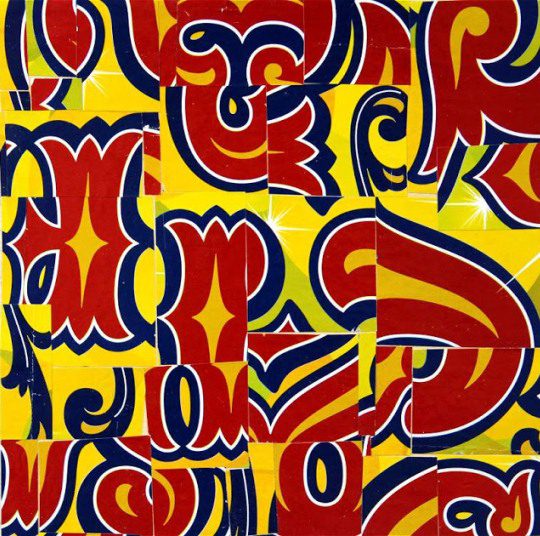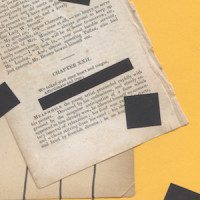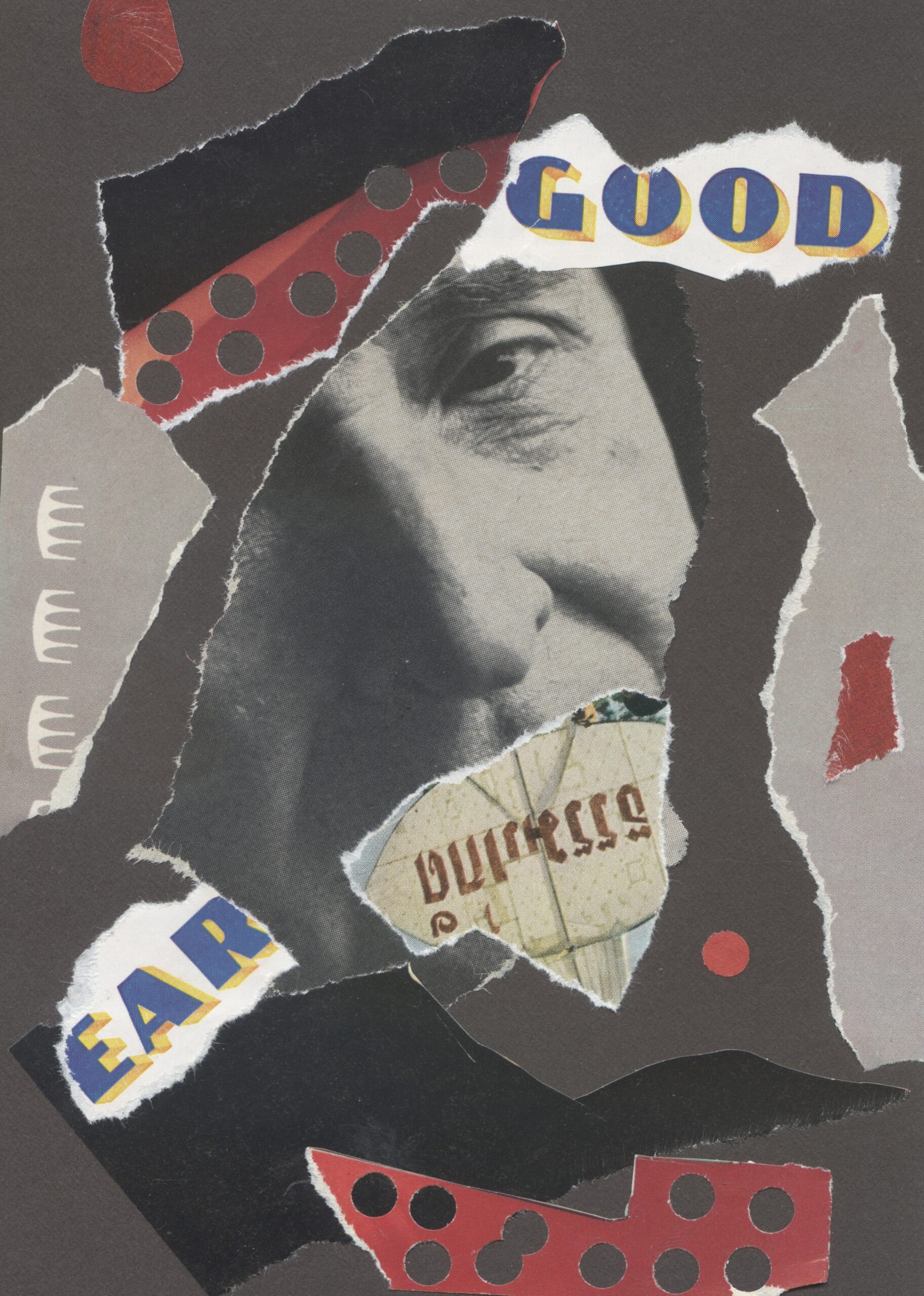Click image to enlarge:
***
Notes on these collages:
- I was trying to push myself in a more abstract direction for this month’s column and was attempting to do work without recognizable central images. My comfort zone in collage is working with faces, bodies, words, and juxtaposition of settings and tones. Inspired by the work of Cecil Touchon (who I interview below) and last month’s interview with Matthew Rose, I’ve been trepidatiously trying to work more abstractly, but I’m not really sure I’m succeeding in this style. Maybe this is a case of failing better (“Ever tried. Ever failed. No matter. Try Again. Fail again. Fail better.” –Samuel Beckett).
- If you tell yourself you’re going to work in an abstract style, is that too premeditated? I wonder if abstract is just another word for accidental. Maybe I should be tearing through stuff and praying for a good accident.
- The first collage is called “Chapter XXII” and includes a page from a book called Pelham; or, The Adventures of a Gentleman by Edward Lytton Bulwer, esq. published in 1837. I put the black squares around it and the black lines with hooks on the top are hand-drawn. I don’t really know how to draw but I want to take some baby steps toward adding hand-drawn (and eventually painted) touches to some of my collages.
- The second collage is called “Good Ear” and includes lettering from a Good Year tires ad as well other scraps from the past week of collaging (instead of recycling scraps like I usually do, I’ve let them pile up more lately). I will cop to the fact that I did lean on one of my usual crutches: A face. There are a couple of scraps that I use here that I had used to make red dots from a hole puncher. Although I feel self-consciously crafty while using my hole puncher, I’ve found some good uses for it recently.
- One thing I’ve found out about those little dots, though, is that can get really messy when you’re gluing down a lot of them.
- I currently have a show up at one of the best cafes in Portland, Crema. It’s called Adventures at the Last Minute and includes over twenty recent collages. It will be up through the month of August.
Paper Trumpets Spotlight: Cecil Touchon
From his home base in Santa Fe, New Mexico, Cecil Touchon creates some of the most beguiling and recognizable collages that have come out of the art world for the past three decades. His mysterious works sometimes look like alien codes, experimental puzzles, or some strange language you’ve never heard of. Through the colors and curves of cut-up text, Touchon’s energetic work somehow congeals and connects and can be funny, beautiful, and disorienting—depending on who’s looking at it. In last month’s column, I mentioned a workshop he was teaching and another one is coming up. I sent him some questions about his work.
The Rumpus: How did you first become interested in collage and what lead you to this typography-influenced work you’re so good at?
Cecil Touchon: I first made collages in college back in probably 1976, but started making collages as a possible form of artistic expression in 1983. I knew an artist who was focused on collage as his main form of art making and after hanging out in his studio and watching him make his work I decided that collage might be my medium. At first my idea was to create a collage-based diary and I determined to go to the number 500. I also decided not to worry about sticking to a certain style or certain materials but to make collages to capture the day so to speak. Once I arrived at 500, I just kept going. I am approaching 4,000 at the moment. On average I have made 100-125 collages a year over more than 30 years. I keep meticulous photographic documentation of my work and for the last few years have been producing an annual catalog of my production. Books and paper have always been a source of fascination for me such as illuminated manuscripts and ephemera of all kinds.
As far as the typographic collages are concerned, typography, since it is a central part of almost any paper based materials, shows up on my work all along. However in the late 90s I decided to use the typographic elements as a singular form to create a sort of abstract visual poetry. The original impulse came from seeing billboards made of plywood in Mexico City in 1998 that had been rearranged to destroy the advertiser’s message once their subscription had run out. I really liked the look and the idea of it so I started experimenting with broken letter compositions and have produced a significant number of works along this line. Years later, as the Internet filled in and more artists’ works were added to the global network, I discovered a number of other artists who have worked in a similar way, such as Carl Andre’s concrete poetry back in the 1950s.
 Rumpus: What are the smallest and biggest collages you’ve made? What’s your usual scale?
Rumpus: What are the smallest and biggest collages you’ve made? What’s your usual scale?
Touchon: I have made collages as small as about 3×3 inches and as large as 5×10 feet. Typical sizes are 6×9 inches, 9×12 inches and 12×18 inches. Most of my collages are those sizes but also square formats from 4×4 to 12×12 inches. I like to stick with roughly book sizes and shapes since most papers fall into these ranges. I don’t like to press found materials beyond their natural sizes and proportions but prefer to keep a reference to the form of the book.
Rumpus: Do you have a favorite language to collage with? Perhaps even a favorite letter?
Touchon: Since I live in an English-speaking world, most of the time I use English, as that is the most plentiful and available. I recently spent a month in Paris and used all French materials but all the letters are the same as English so it doesn’t make that much difference since most of the time the letters are intentionally cut to be unreadable. I have however experimented with Sumerian and Southeast Asian lettering. I also often work with language-like brush marks and cut these up and use them for material.
Rumpus: Tell me more about your connection to poetry and this “massurrealistic” style?
Touchon: Massurrealism was invented by my friend James Seehafer back in the 1990s. I think in terms of my ideas of the “Massurreality” which I define as a global mind world created by ubiquitous media such as television, radio, and the Internet. This is a mental world that we all share via our participation in and observation of mass media. In terms of collage poetry I draw material from this mental landscape and gather it into unrelated lines of text from various processes such as keyword searches on Google or from spam email or news transcripts, headlines, etc. I have probably constructed a thousand such poems by now. I am not a poet in the traditional sense of personal self-expression. I am more of an arranger of things or a designer of systems for gathering interesting information. While I have published a number of books of poetry and occasionally interact with avant garde poets online, traditional literary poetry and the general poetry scene does not interest me very much.
Rumpus: What kind of advice would you give to young artists who are just starting to collage? Are there certain clichés you tell students to avoid?
Touchon: I would suggest that young artists at the beginnings of their careers explore whatever is of interest to them, study modern and contemporary art history to be aware of how collage developed and how it is advancing in the community now, to take their fun and their work seriously, to collect as much and as diverse paper materials as possible, to interact and maybe collaborate with other collagists. Be as organized as possible; paper can become unruly! One can join the community at collagist.org. It can take a long time to find one’s voice using found materials but it is certainly possible. A love of paper, history, culture, surface, and composition is important. Don’t get lost in the romance of the paper.
For those wanting to work professionally, I think an artist has to be very disciplined in terms of invention and production. Do what ever it takes to establish your studio. Invest in yourself. Make time to work. Document and inventory everything. Get a good camera and computer. Don’t let days go by without working in the studio, this can seem very difficult, but to make any progress that is what you have to do. If you are just doing it as a hobby, I would probably say the same thing. To really enjoy making collage art or any art it has to become part of your life. Consider getting involved in Mail Art and exchange things with other artists. That can help give purpose to your activity.
Rumpus: Can you tell me more about The International Museum of Collage and its goals for the future?
Touchon: The International Museum of Collage is about museum as art project: as a kind of grand assemblage. So it is about the art, the artist community that contributes to it, and the capacity for researching the medium. It is hard to calculate what are reasonable goals for its future because it is always run on a shoestring. But like any work of art, an artist creates a problem and then sets about attempting to solve it. So the museum is an ongoing lifetime project and the ultimate goal is to create a record of the contemporary moment for the future, to compete for a place in art history by archiving the parts that are usually left out. So it is really a rather radical and ambitious project—to create an archive of art that didn’t have to go through the gauntlet of the upper end of the art market where most museum collections come from. Most collage artists are not even in the market. It is difficult to be in the art market and it can take many, many years to develop a following and that’s if you are working day and night in your studio and have some luck in the galleries. So there is not the same filter system with the Collage Museum. It is more inclusive than exclusive. But maybe some very wealthy person will come along sometime in the future and fund the project. Who knows? In the meantime we just keep going. This is why we just opened a commercial gallery of collage and assemblage art associated with the museum, to help raise the money to support museum programing.






